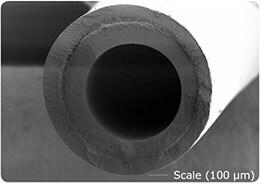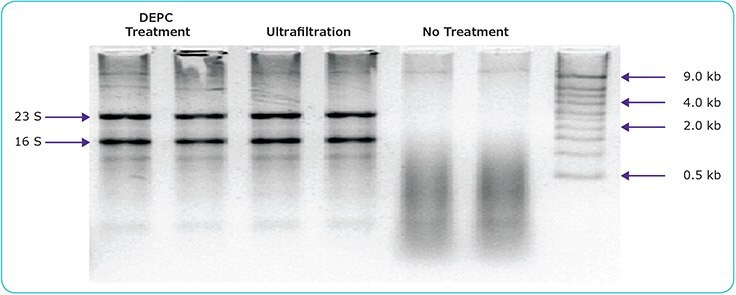Nuclease-Free Water at Your Fingertips
Estelle Riche, Stephane Mabic
Millipore S.A.S, Lab Water, Saint-Quentin-en-Yvelines, France
Abstract
Nuclease-free glassware and reagents are required for many molecular biology applications. Chemical treatment with diethylpyrocarbonate (DEPC) has long been a common practice to generate nuclease-free water, but this method has several drawbacks. Alternatively, an ultrafiltration cartridge can be placed at the outlet of a water purification system in order to deliver nuclease-free ultrapure water that can directly be used for experiments.
Introduction
Nucleases degrade DNA and RNA by cleaving the phosphodiester bonds of the nucleic acid backbone. While some nucleases are useful research tools, they are often a concern for scientists looking to preserve sample integrity for applications such as PCR, cloning, sequencing, or gene editing. For this reason, scientists working with nucleic acids require nuclease-free reagents and containers. Water, as the major component of buffers and reagents, should also be nuclease-free. Unfortunately, nucleases are ubiquitous in the laboratory: they are commonly present on plasticware and in reagents, and may even originate from the scientists themselves (skin, saliva, etc.).1 They are also very stable and difficult to inactivate;2 therefore, DEPC treatment is often used to eliminate them from solutions. Ultrafiltration is presented here as a convenient and safe alternative to DEPC treatment for the preparation of nuclease-free water.
Results and discussion
Nuclease contamination of reagents used in molecular biology, and particularly water, may lead to inconsistent results or loss of valuable samples. DEPC is an efficient, nonspecific inhibitor of RNase and has been used for many years to inactivate RNases.3 Chemical treatment of solutions with DEPC is an efficient method, but it presents several drawbacks:
- Safety concerns. DEPC is a suspected carcinogen, as it may react with purines, and should be handled with caution. In addition, if the bottle is exposed to traces of moisture from the air at room temperature, DEPC may hydrolyze. This will generate carbon dioxide, which will lead to potentially dangerous pressure buildup.4
- Time and energy consumption. Some time is required for the chemical reaction between DEPC and nucleases to occur, and then for autoclaving the solution, which is required in order to destroy the DEPC. In addition, autoclaving consumes large amounts of water and electricity.
- Introduction of impurities that may affect experiments. When DEPC is hydrolyzed during autoclaving, ethanol and carbon dioxide are released (Figure 1). Ethanol may react with impurities or reagents used in later experimental steps, potentially generating unwanted by-products. In addition, DEPC has a strong affinity for adenosine, and even if only traces of DEPC remain in solution, they may compromise experimental results by modifying adenosine nucleotides (Blots, PCR reactions, etc.).1 DEPC traces may also react with amine groups and mercaptans.
- Nucleases are not removed from the water, but merely inactivated by chemical reaction with DEPC.

Figure 1.Degradation of DEPC releases contaminants into water.
Ultrafiltration was tested as an alternative method to generate nuclease-free water. This process uses hollow fibers to separate contaminants based on their size. A disposable cartridge containing 13 000 Da nominal molecular weight limit (NMWL) cut-off polysulfone ultrafiltration fibers was tested (Figure 2).

Figure 2.Polysulfone hollow fiber used for ultrafiltration in the Biopak® cartridge.
Figure 3 shows that the rRNA remained intact when the RNase solution was first filtered using ultrafiltration. In comparison, conventional DEPC treatment of the RNase solution similarly prevented rRNA degradation. As a control, when the RNase solution was left untreated, rRNA was digested. This demonstrates that the efficiency of RNase removal by ultrafiltration is equivalent to the inactivation of RNase activity by DEPC treatment.5

Figure 3.Gel electrophoresis of rRNA in water previously spiked with RNase and either DEPC-treated, ultrafiltered, or left untreated.
Experimental section
Ultrapure water was spiked with RNase A and divided into three aliquots. The solutions were either (1) treated with DEPC and autoclaved; (2) treated with ultrafiltration through a Biopak® ultrafiltration polisher; (3) not treated. Ribosomal RNA was added to each solution, incubated for 20 minutes, and then agarose gel electrophoresis in denaturing conditions was performed.
Conclusion
Nuclease-free water is required for many molecular biology applications. Unlike DEPC treatment, which is time-consuming and cumbersome, using an ultrafiltration cartridge is a safe and convenient way to obtain nuclease-free water from a water purification system.
This method has many benefits for scientists:
- On demand, convenient. Freshly purified nuclease-free water can easily be produced when it is needed. There is no need to order bottled nuclease-free water in advance, or to spend time treating water with DEPC before performing experiments.
- No risk. No manipulation of chemicals is required. Also, since no chemicals are added to the water, there is no risk of interference with other reagents.
- High purity nuclease-free water. Ultrafiltration removes nucleases from water instead of merely inactivating them. Since the cartridge is designed to be connected to the outlet of a water purification system, such as a Milli-Q®, one can obtain ultrapure water that is also free of nucleases.
Acknowledgments
The authors are grateful to Julien Bole and Ichiro Kano for their technical expertise.
References
To continue reading please sign in or create an account.
Don't Have An Account?